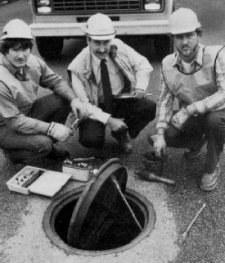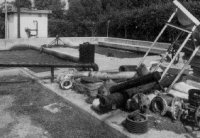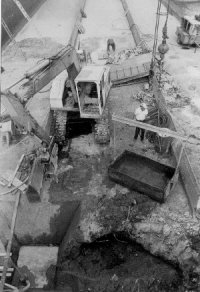Industrial waste had been a problem for generations, since the days when wastes from meat packing plants clogged the sewers and acid discharges from distilleries eroded concrete pipes. The hexa-octa dumping in 1977, and the sewer explosion of 1981, were Louisville’s worst examples of the damages that could be caused — but there were many smaller spills and discharges that damaged the sewers, disturbed the treatment process and polluted the streams.
The problem, in nearly every case, was that spills and even intentional discharges were usually hard to anticipate, hard to detect and hard to trace to their sources.
In the early 1980s, the Environmental Protection Agency added its muscle to the program; industries had to obtain permits to discharge wastewater into sewers, and the permits limited the amounts of a wide range of substances that would be allowed in their wastewater. When MSD launched this program in 1981, 46 out of 148 companies failed to comply.
Accidental spills were a more difficult matter. Gasoline, acids, solvents, ammonia, ingredients for plastic, and a wide assortment of chemicals were being spilled onto the ground, onto the streets, and into the sewers and streams. No single agency was in charge of dealing with them; no single agency even kept track of them. And there was no enforcement authority to deal with the bad actors.
In September, 1984, MSD prepared a detailed report on the problem, suggesting a complete overhaul of the system for reporting and dealing with spills, along with requirements that businesses and industries using hazardous materials prepare detailed plans for spill cleanup and containment.
Within days, Louisville Mayor Harvey Sloane formed a task force to investigate the proposal. In February, 1985, the task force completed work on a hazardous materials ordinance and sent it to the Louisville Board of Aldermen and Jefferson Fiscal Court. The ordinance was passed by both bodies, and took effect that November. MSD was the agency designated to administer and enforce it.
It was the first example of MSD identifying a public need, proposing a solution, and taking responsibility for a major new program. It was also one of the nation’s first comprehensive local government chemical spill prevention programs.

Courier-Journal and Louisville Times Photo by Michael Hayman
The Public’s Priorities
In mid-1984, the Strategic Planning and Finance Committee asked for a public opinion survey on sewer issues and the community’s experiences with sewer and drainage problems. The survey was conducted that fall by the University of Louisville’s Urban Studies Center, which polled 805 adult residents of Louisville and Jefferson County.
In January, 1985, the results were announced. Among the highlights:
- 66 percent favored improving the sewers, as long as the costs were shared fairly.
- About 70 percent gave top priority to upgrading the existing sewer system.
- About 60 percent favored extending sewers to new areas; this was a top priority in the northeastern part of the county.
- About 60 percent favored improved stormwater drainage; this was a top priority in the western part of the county.
- The survey showed that the public’s basic priorities were very close to MSD’s own list of challenges — information that would prove to be very helpful as the committee continued its study.
A New Image
In July, 1985, with the county sewer expansion program back on track and the Morris Forman plant showing increased efficiency, a Courier-Journal editorial praised "the turnaround at MSD," saying the agency "has done more than anyone familiar with its recent history could have imagined possible to regain credibility and start providing an adequate, comprehensive sewer system for the entire county."
The early 1980s found the community facing increasing problems with aging sewer systems and treatment plants, as well as the problems of septic tanks and sewer expansions.

Courier-Journal and Louisville Times Photo by Michael Coers

MSD Photo by Martin E. Biemer
MSD History continued - Metropolitan Services


